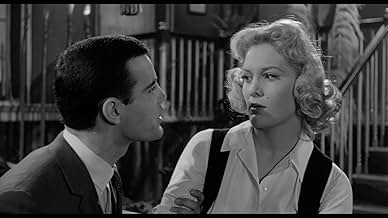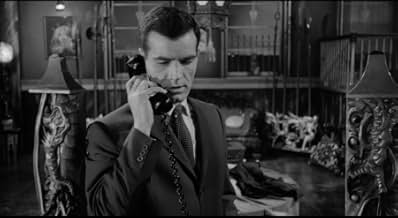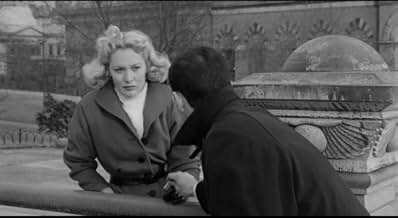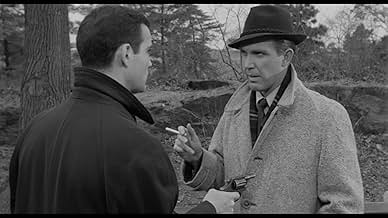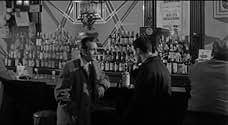A detective investigating the murder of a heroin addict discovers that there is a connection between the junkie and his fiancee, who is his boss' daughter.A detective investigating the murder of a heroin addict discovers that there is a connection between the junkie and his fiancee, who is his boss' daughter.A detective investigating the murder of a heroin addict discovers that there is a connection between the junkie and his fiancee, who is his boss' daughter.
- Director
- Writers
- All cast & crew
- Production, box office & more at IMDbPro
Featured reviews
This low-budget, independent picture's most significant point of interest is its writing pedigree -- it's based on a novel by hard-boiled favorite Ed McBain, with a screenplay by the best-selling novelist Harold Robbins. This contributes to a very schizophrenic result. The influence of the former is obvious in the police procedural framework, with some interesting shot-on-location scenes in Spanish Harlem and other NYC locales. The latter's heavy hand is apparent in the overblown melodramatic scenes which especially mar the last couple of reels.
The story concerns a police detective who, while investigating the apparent suicide of a young Puerto Rican heroin addict, discovers that his middle-class daughter is involved in the same underworld. The parallels/contrasts between the white-bread girl and the poverty stricken ethnic types gives this exposé its main social significance -- presaging similar scenes in much more accomplished films like "Traffic". But of course, the good-girl-gone-bad scenario was a staple of old-time exploitation pix way back in the days of silent movies and Dwain Esper.
Unfortunately, the filmmakers, though competent enough for the most part, really have no sense of style or tension, and the film just staggers monotonously from sequence to sequence. It only comes to life during the scenes with a feisty Latin cabaret dancer (the boy's sister), and in the character of the slick pusher who lures the girls into a life of addiction and takes advantage of them in his Playboy-style bachelor pad. Though the subject matter was probably sensational at the time, most modern viewers will find the dramatic scenes clichéd and unsubtle, and the action scenes clumsy. The jazzed-up version of "Billy Boy" that reverberates on the soundtrack is a futile attempt at hipness.
The director was a top-notch Hollywood editor, but this was his only session at the helm of a movie. Watch for some absurdly intense, method-style emoting by the young actors playing gang members.
The story concerns a police detective who, while investigating the apparent suicide of a young Puerto Rican heroin addict, discovers that his middle-class daughter is involved in the same underworld. The parallels/contrasts between the white-bread girl and the poverty stricken ethnic types gives this exposé its main social significance -- presaging similar scenes in much more accomplished films like "Traffic". But of course, the good-girl-gone-bad scenario was a staple of old-time exploitation pix way back in the days of silent movies and Dwain Esper.
Unfortunately, the filmmakers, though competent enough for the most part, really have no sense of style or tension, and the film just staggers monotonously from sequence to sequence. It only comes to life during the scenes with a feisty Latin cabaret dancer (the boy's sister), and in the character of the slick pusher who lures the girls into a life of addiction and takes advantage of them in his Playboy-style bachelor pad. Though the subject matter was probably sensational at the time, most modern viewers will find the dramatic scenes clichéd and unsubtle, and the action scenes clumsy. The jazzed-up version of "Billy Boy" that reverberates on the soundtrack is a futile attempt at hipness.
The director was a top-notch Hollywood editor, but this was his only session at the helm of a movie. Watch for some absurdly intense, method-style emoting by the young actors playing gang members.
For some reason, "The Pusher" sat on the shelf for two years until it was finally released to theaters. I have no idea why, as usually this means the film is terrible...but there's nothing terrible about this movie. It's excellent...and holds up well all these years later.
The story is about a particularly vicious drug dealer. Not only does he sell heroin, but he doesn't like to leave any loose ends...which means he's more than happy to kill anyone...even his own clients or a cop! The problem is that the detective investigating doesn't realize that his own fiancee is one of the killer's clients. To make it worse, her father is a police lieutenant! Can the cops manage to notice that their lead to the killer's identity is right there in front of them?!
While the film is very realistic in depicting drug abuse, it's not a film noir movie. It focuses more on realism as opposed to sensationalism. Well worth seeing and never dull.
By the way, this film is John Astin's movie debut. He is only briefly seen near the beginning of the picture and barely says anything. I guess they had no idea he'd one day be a star.
The story is about a particularly vicious drug dealer. Not only does he sell heroin, but he doesn't like to leave any loose ends...which means he's more than happy to kill anyone...even his own clients or a cop! The problem is that the detective investigating doesn't realize that his own fiancee is one of the killer's clients. To make it worse, her father is a police lieutenant! Can the cops manage to notice that their lead to the killer's identity is right there in front of them?!
While the film is very realistic in depicting drug abuse, it's not a film noir movie. It focuses more on realism as opposed to sensationalism. Well worth seeing and never dull.
By the way, this film is John Astin's movie debut. He is only briefly seen near the beginning of the picture and barely says anything. I guess they had no idea he'd one day be a star.
God damn the Pusher man. He's got the snazziest digs, wears the sharpest threads, snags the hottest dames, and makes it all look easy. As played by natty hipster Felice Orlandi (Renick in BULLITT), he's like a Bizarro World Hugh Hefner, albeit with a pocketful of smack. This guy is the personification of quiet cool -- that is, until he becomes the object of vengeance by a junkie's unrelenting father, who just happens to be a police lieutenant.
Based on an Ed McBain 87th Precinct novel, THE PUSHER is less a police procedural than a sleazy, heavy-breathing crime meller, which should come as no surprise since Harold Robbins wrote the screenplay.
Personally I wouldn't have it any other way.
Thanks to Robbins' unerring bad taste, the movie is lurid, lowdown fun, chock full of runny noses, twitchy mannerisms, overwrought withdrawals, and all manner of salacious misdoings. Unfortunately, thanks to first-time helmer Gene Milford, it also boasts the dullest, dreariest direction this side of an Edward L. Cahn opus. Hey, life''s full of trade-offs.
On the plus side, the film boasts evocative location photography by ace Big Apple d.p. Arthur Ornitz, a nifty score by renaissance music man Raymond Scott and attention-grabbing performances by Orlandi, Robert Lansing (as 87th Precinct regular Steve Carella) and Sara Amman, a five-alarm Latin hottie who performs a grind-till-you--lose-your-mind specialty dance that's worth the price of admission alone.
Based on an Ed McBain 87th Precinct novel, THE PUSHER is less a police procedural than a sleazy, heavy-breathing crime meller, which should come as no surprise since Harold Robbins wrote the screenplay.
Personally I wouldn't have it any other way.
Thanks to Robbins' unerring bad taste, the movie is lurid, lowdown fun, chock full of runny noses, twitchy mannerisms, overwrought withdrawals, and all manner of salacious misdoings. Unfortunately, thanks to first-time helmer Gene Milford, it also boasts the dullest, dreariest direction this side of an Edward L. Cahn opus. Hey, life''s full of trade-offs.
On the plus side, the film boasts evocative location photography by ace Big Apple d.p. Arthur Ornitz, a nifty score by renaissance music man Raymond Scott and attention-grabbing performances by Orlandi, Robert Lansing (as 87th Precinct regular Steve Carella) and Sara Amman, a five-alarm Latin hottie who performs a grind-till-you--lose-your-mind specialty dance that's worth the price of admission alone.
Gene Milford did not build a household name, even in the realm of B productions like THE PUSHER . I have not seen anything else done by him, but THE PUSHER deserves above average rating.
One curiosity is that 1958 is the year that appears in the opening credits, but IMDB makes it 1960. Was in production for two years? It looks so shoestring that I doubt it, to be honest.
Albeit offering a generally realistic view of New York between those years, the film opens by introducing you to Lt Byrne, his wife, his daughter Laura, and the latter's boyfriend, Steve, also a copper. All, law abiding, all likable... but you discover very rapidly that Laura begins to stray, taking drugs on the quiet. She knows what she is doing, the dangers involved, the impact on her father and boyfriend, and she is convinced she can kick the habit but she just keeps diving deeper into it, getting her stuff from "Ganzo", another name for the pusher, who is very credibly played by prim and proper looking Felice Orlandi.
Of course, moral and family issues rise to the surface, and Lt Byrhe becomes extremely interested in the case when he gets what is happening with Laura and helps her with cold turkey treatment.
It makes you think that by 1958/1960 drug trafficking still seemed a minor and relatively containable problem, and yet since then even the finest police force in the world, US Police, has not managed to reduce it significantly, let alone stop it. And with new drugs being engineered full time, like crack, ecstasy, fentanyl, and all the rest of it, the common citizen has become more and more a target for the panoply of pushers, sellers, and others keeping that infamous trade ticking.
Sadly, by the time this well-meaning, honest film wrapped up, I could only think that mankind heeds no warning, however clear, and in the long run it is condemning itself to extinction for the sake of enriching drug lords.
Strong B noir photography by Arthur Ornitz, credible screenplay by Evan Hunter. 7/10.
One curiosity is that 1958 is the year that appears in the opening credits, but IMDB makes it 1960. Was in production for two years? It looks so shoestring that I doubt it, to be honest.
Albeit offering a generally realistic view of New York between those years, the film opens by introducing you to Lt Byrne, his wife, his daughter Laura, and the latter's boyfriend, Steve, also a copper. All, law abiding, all likable... but you discover very rapidly that Laura begins to stray, taking drugs on the quiet. She knows what she is doing, the dangers involved, the impact on her father and boyfriend, and she is convinced she can kick the habit but she just keeps diving deeper into it, getting her stuff from "Ganzo", another name for the pusher, who is very credibly played by prim and proper looking Felice Orlandi.
Of course, moral and family issues rise to the surface, and Lt Byrhe becomes extremely interested in the case when he gets what is happening with Laura and helps her with cold turkey treatment.
It makes you think that by 1958/1960 drug trafficking still seemed a minor and relatively containable problem, and yet since then even the finest police force in the world, US Police, has not managed to reduce it significantly, let alone stop it. And with new drugs being engineered full time, like crack, ecstasy, fentanyl, and all the rest of it, the common citizen has become more and more a target for the panoply of pushers, sellers, and others keeping that infamous trade ticking.
Sadly, by the time this well-meaning, honest film wrapped up, I could only think that mankind heeds no warning, however clear, and in the long run it is condemning itself to extinction for the sake of enriching drug lords.
Strong B noir photography by Arthur Ornitz, credible screenplay by Evan Hunter. 7/10.
This film begins with a young man being found dead in a clubhouse by what appears to be suicide. At the same time, however, the police also find a hypodermic syringe near his body which puts things in doubt pending an autopsy. Sure enough, the subsequent autopsy reveals that the victim had injected a high concentration of heroin and since his death is now ruled as an overdose the detective in charge of the case "Lt. Peter Byrne" and his partner "Steve Carella" begin to direct their efforts to finding the pusher who supplied him. Meanwhile, the detective's daughter "Laura Byrne" has been behaving slightly different the last few weeks which Lt. Byrne initially concludes is due to her upcoming marriage to her fiancé-Steve Carella. What neither the detective nor Steve know, however, is that Laura has recently become addicted to heroin and she gets her drugs from the same person the police are looking for. Now rather than reveal any more I will just say that this film turned out to be slightly better than I had expected due in large part to the overall gloomy atmosphere and the subject matter at hand during this particular time-period. Yet at the same time, there were a couple of scenes which I thought were overly simplistic and lacked the necessary realism. But by and large I thought that this was a decent film for the most part and for that reason I have rated it accordingly. Average.
Did you know
- TriviaFilm debut of John Astin.
- ConnectionsFeatured in Frightful Movie: The Pusher (1968)
Details
- Release date
- Country of origin
- Official site
- Language
- Also known as
- Narkotika
- Filming locations
- 113 East 115 Street, New York City, New York, USA(Location where Anibal Hernandez's Body was found by Police)
- Production company
- See more company credits at IMDbPro
Box office
- Gross US & Canada
- $1,656
- Opening weekend US & Canada
- $1,656
- May 9, 1999
- Gross worldwide
- $1,656
- Runtime
- 1h 21m(81 min)
- Color
- Sound mix
- Aspect ratio
- 1.37 : 1
Contribute to this page
Suggest an edit or add missing content

